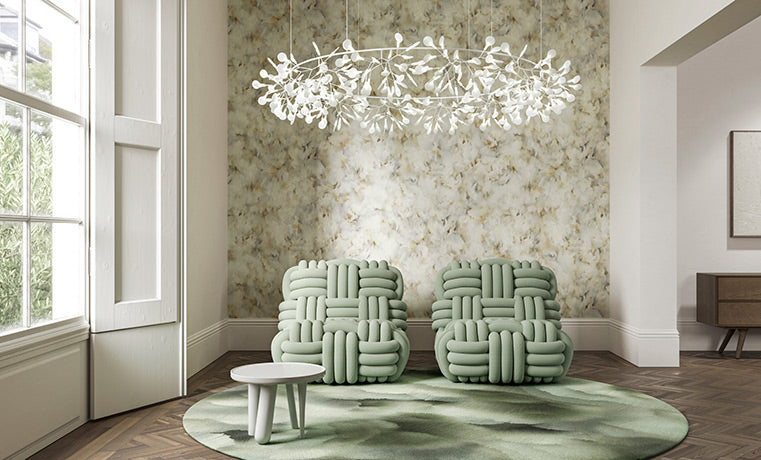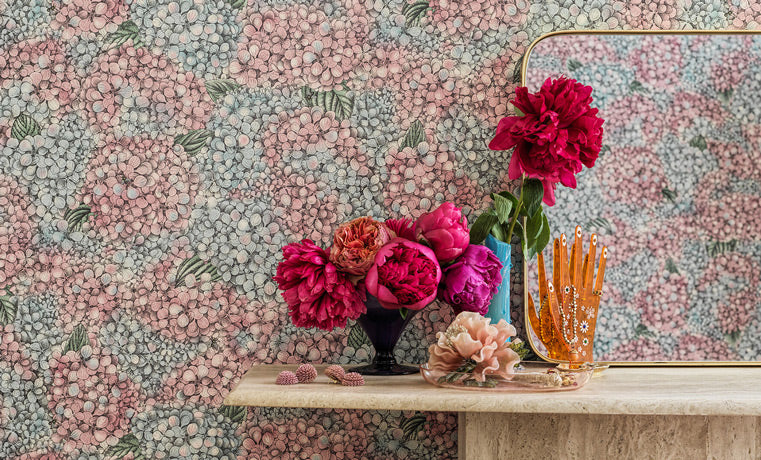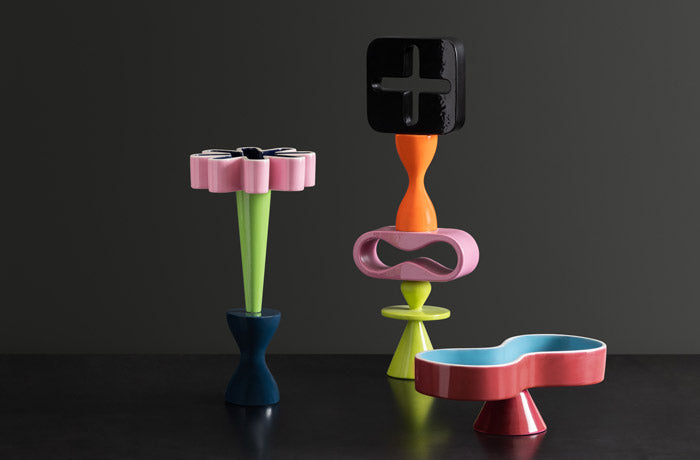
(Tessa (Triad 7) – 1974) New ‘Triad’ collections, by 1974 including co-ordinates as well as exact matches, were introduced every two years until the 1970′s, when Lowe, as Design Director, had charge of Pat Smart and Will King, designers in the hand-printing wallpaper unit, and Paul Haines managed the Perivale design studio. When continuing to purchase designs form outside studios and freelance designers, Lowe fostered in-house designers in the fabric division. Among these Robert Holmes, Pat Etheridge and Devina Spring each in turn became Design Managers and remained successful designers after they had left the company, often still contributing to Sanderson ranges, others fostered during these years were the many recipients of the Sanderson awards given to RCA graduates, with which the company retained close contracts. Meanwhile, Sanderson had undergone radical change with the break-up of the WPM in 1965, when Reed International purchased the firm. One result was the transfer to Sanderson of the architectural ‘Palladio’ wallpaper collections, initiated in 1955 by Richards Busby, director of Lightbown Aspinall. ‘Palladio 8′, orchestrated by Eddie Pond, head of the WPM studio – now based at Berners Street’s Central Studio – launched in 1968; ‘Palladio 9′, the last, arrived in 1971. Contributing designers included Pat Albeck, Inge Cordson, Natalie Gibson, Deryck Healey, Althea McNish and Zandra Rhodes.

(Christchurch (Triad 7) 1974) In 1964, in keeping with the company’s diversity. Lowe introduced fabrics resized and re-coloured from Morris & Co. wallpaper designs (which Sanderson began printing in 1927) and, in 1968, ‘Young Sanderson’ ranges, all the while continuing the supply of luxuriant floral patterns, many from the hand of Kenneth Truman. All of these design concepts influenced the hugely popular ‘Triad’ collections and by 1974 the Morrisian and chintz styles coincided with the range for ‘Victoriana’. For example, the V&A’s Aubrey Beardsley exhibition in 1966 directly inspired a Sanderson wallpaper design. In a trend set in no small part by Sanderson, increasingly historical designs came to dominate both ‘decorator’ and mainstream interiors by the mid-1970′s. Sanderson thereafter continued to move with the time and, recognising the renewed appreciation for 1950′s patterns re-released several such designs during it’s 151st year in 2001.
 (Tessa (Triad 7) – 1974) New ‘Triad’ collections, by 1974 including co-ordinates as well as exact matches, were introduced every two years until the 1970′s, when Lowe, as Design Director, had charge of Pat Smart and Will King, designers in the hand-printing wallpaper unit, and Paul Haines managed the Perivale design studio. When continuing to purchase designs form outside studios and freelance designers, Lowe fostered in-house designers in the fabric division. Among these Robert Holmes, Pat Etheridge and Devina Spring each in turn became Design Managers and remained successful designers after they had left the company, often still contributing to Sanderson ranges, others fostered during these years were the many recipients of the Sanderson awards given to RCA graduates, with which the company retained close contracts. Meanwhile, Sanderson had undergone radical change with the break-up of the WPM in 1965, when Reed International purchased the firm. One result was the transfer to Sanderson of the architectural ‘Palladio’ wallpaper collections, initiated in 1955 by Richards Busby, director of Lightbown Aspinall. ‘Palladio 8′, orchestrated by Eddie Pond, head of the WPM studio – now based at Berners Street’s Central Studio – launched in 1968; ‘Palladio 9′, the last, arrived in 1971. Contributing designers included Pat Albeck, Inge Cordson, Natalie Gibson, Deryck Healey, Althea McNish and Zandra Rhodes.
(Tessa (Triad 7) – 1974) New ‘Triad’ collections, by 1974 including co-ordinates as well as exact matches, were introduced every two years until the 1970′s, when Lowe, as Design Director, had charge of Pat Smart and Will King, designers in the hand-printing wallpaper unit, and Paul Haines managed the Perivale design studio. When continuing to purchase designs form outside studios and freelance designers, Lowe fostered in-house designers in the fabric division. Among these Robert Holmes, Pat Etheridge and Devina Spring each in turn became Design Managers and remained successful designers after they had left the company, often still contributing to Sanderson ranges, others fostered during these years were the many recipients of the Sanderson awards given to RCA graduates, with which the company retained close contracts. Meanwhile, Sanderson had undergone radical change with the break-up of the WPM in 1965, when Reed International purchased the firm. One result was the transfer to Sanderson of the architectural ‘Palladio’ wallpaper collections, initiated in 1955 by Richards Busby, director of Lightbown Aspinall. ‘Palladio 8′, orchestrated by Eddie Pond, head of the WPM studio – now based at Berners Street’s Central Studio – launched in 1968; ‘Palladio 9′, the last, arrived in 1971. Contributing designers included Pat Albeck, Inge Cordson, Natalie Gibson, Deryck Healey, Althea McNish and Zandra Rhodes.  (Christchurch (Triad 7) 1974) In 1964, in keeping with the company’s diversity. Lowe introduced fabrics resized and re-coloured from Morris & Co. wallpaper designs (which Sanderson began printing in 1927) and, in 1968, ‘Young Sanderson’ ranges, all the while continuing the supply of luxuriant floral patterns, many from the hand of Kenneth Truman. All of these design concepts influenced the hugely popular ‘Triad’ collections and by 1974 the Morrisian and chintz styles coincided with the range for ‘Victoriana’. For example, the V&A’s Aubrey Beardsley exhibition in 1966 directly inspired a Sanderson wallpaper design. In a trend set in no small part by Sanderson, increasingly historical designs came to dominate both ‘decorator’ and mainstream interiors by the mid-1970′s. Sanderson thereafter continued to move with the time and, recognising the renewed appreciation for 1950′s patterns re-released several such designs during it’s 151st year in 2001.
(Christchurch (Triad 7) 1974) In 1964, in keeping with the company’s diversity. Lowe introduced fabrics resized and re-coloured from Morris & Co. wallpaper designs (which Sanderson began printing in 1927) and, in 1968, ‘Young Sanderson’ ranges, all the while continuing the supply of luxuriant floral patterns, many from the hand of Kenneth Truman. All of these design concepts influenced the hugely popular ‘Triad’ collections and by 1974 the Morrisian and chintz styles coincided with the range for ‘Victoriana’. For example, the V&A’s Aubrey Beardsley exhibition in 1966 directly inspired a Sanderson wallpaper design. In a trend set in no small part by Sanderson, increasingly historical designs came to dominate both ‘decorator’ and mainstream interiors by the mid-1970′s. Sanderson thereafter continued to move with the time and, recognising the renewed appreciation for 1950′s patterns re-released several such designs during it’s 151st year in 2001.





